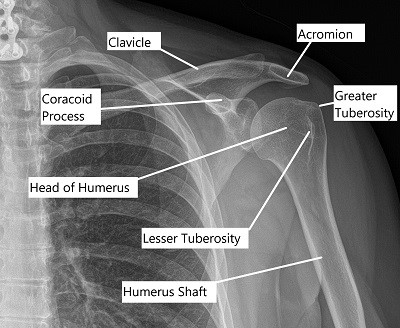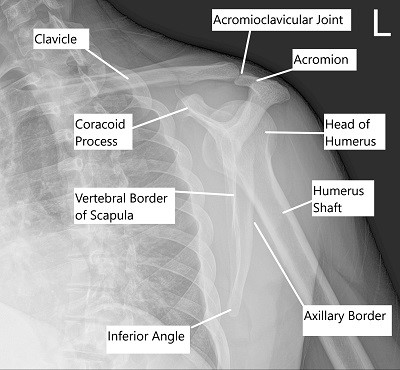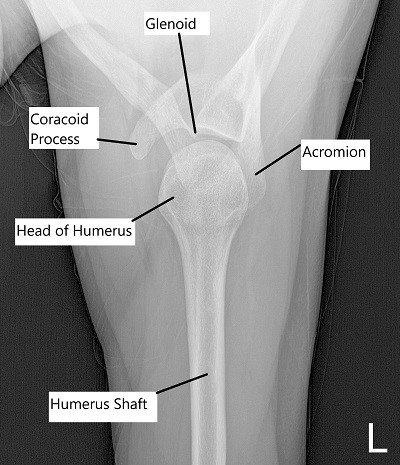Shoulder Anatomy
The acromioclavicular (AC) joint is where the clavicle (collarbone) meets the acromion of the scapula (shoulder blade). Despite being a small joint, the AC joint plays a vital role in stabilizing the shoulder and enabling a wide range of upper limb movements. It is crucial for overhead motions and movements involving the arm across the body. Common pathologies of the AC joint, such as arthritis, sprains, and separations, can significantly impair shoulder function and quality of life.

Axial view of left shoulder.
Glenohumeral Joint
The Glenohumeral or the real shoulder joint is made up of the articulation of the ball of the head of the arm bone called the humerus into the cup of the shoulder blade called the scapula.
The cup makes only 1/8th of the circumference of the shoulder and hence the shoulder joint is seemingly unstable, especially if compared to other large ball and socket joints of the body that is the hip joint. The joint can be involved in arthritis and well as fractures and sprains
Acromioclavicular Joint
The acromioclavicular joint (AC joint) is formed by articulation of the shoulder blade (scapula) and the collar bone (clavicle) and is enclosed by a joint (AC) capsule and supported by multiple ligaments.
It can be felt under the skin in front and over the top of the shoulder. AC joints can be involved in acute presentation leading to AC sprain of various grades (shoulder separation). It can also be involved by arthritis causing pain over time.

Transscapular view of Left shoulder.

Anteroposterior view of Left Shoulder.
Stability of Glenohumeral Joint
The cup of the shoulder joint is deepened secondary to the presence of a fibrocartilaginous rim around the cup of the shoulder in the form of a gasket called the labrum. This provides some degree of stability to the shoulder joint.
The stability of the shoulder joint is further strengthened by the capsule of the shoulder joint as well as the surrounding muscles which keep the head or the bulb of the humerus in place over the cup.
The capsule and the labrum can be injured in an accident leading to shoulder dislocation or due to repetitive trauma caused by certain sports like baseball and volleyball, leading to instability and the shoulder popping out.
Functional Anatomy
The AC joint is a diarthrodial (synovial) joint that allows limited movement between the acromion and the clavicle. The joint is stabilized by a joint capsule, ligaments, and the surrounding muscles. The acromioclavicular ligament provides horizontal stability, and the coracoclavicular ligaments (trapezoid and conoid) provide vertical stability. These ligaments prevent excessive movement, ensuring that the clavicle and scapula remain aligned during shoulder movements.
Biomechanics or Physiology
The AC joint allows for gliding motion, especially during movements such as shoulder elevation, protraction, and retraction. The clavicle rotates 40-50° posteriorly with shoulder elevation, while the AC joint contributes around 8° of rotation. These motions are crucial for the movement of the arm during various tasks, from lifting objects overhead to throwing. The coracoclavicular ligaments are particularly important for resisting vertical loads, and the acromioclavicular ligament stabilizes horizontal movement.
Common Variants and Anomalies
The AC joint can undergo degenerative changes due to age, trauma, or overuse. Osteoarthritis (OA) of the AC joint is common in older adults or those with prior shoulder trauma. AC joint separations, which result from direct impact or falls, are common in contact sports and can lead to varying degrees of deformity. In some cases, osteophytes (bone spurs) can develop, impinging on the surrounding tissues, such as the rotator cuff.
Clinical Relevance
The AC joint is involved in a variety of conditions that can significantly affect shoulder function. Arthritis of the AC joint leads to pain, particularly during overhead activities. AC joint separation, often caused by trauma or sports injuries, can result in pain, swelling, and instability. Bursitis (inflammation of the bursa) and tendonitis of surrounding muscles (such as the rotator cuff) are often seen in conjunction with AC joint problems. Understanding the anatomy and function of the AC joint is key to diagnosing and treating these conditions.
Imaging Overview
To assess AC joint injuries, X-rays are commonly used to evaluate bone alignment, detect fractures, and identify joint degeneration. MRI provides detailed soft tissue images, allowing for the assessment of cartilage wear, inflammation of the surrounding muscles, and rotator cuff injuries. CT scans may be used in complex cases, especially for visualizing fractures or malalignment of the AC joint. Ultrasound can also be helpful in diagnosing bursitis and tendonitis.
Associated Conditions
The most common pathologies associated with the AC joint include:
-
AC Joint Separation: Typically caused by direct trauma to the shoulder. This can result in grade I, II, or III separations, which range from mild sprains to complete ligament rupture.
-
Osteoarthritis: Degeneration of the cartilage in the AC joint, leading to pain, stiffness, and loss of mobility.
-
Bursitis: Inflammation of the subacromial bursa, which can cause pain during overhead activities.
-
Rotator Cuff Tendonitis: Inflammation of the tendons of the rotator cuff muscles that can be associated with AC joint pathology.
-
Impingement Syndrome: Bone spurs or inflammation of the AC joint can lead to impingement of the rotator cuff tendons, causing pain and dysfunction.
Surgical or Diagnostic Applications
Diagnosis begins with a thorough clinical evaluation, including history and physical examination to assess the location and severity of pain. Tests like the Cross-Body Adduction Test and O’Brien’s Test can help identify AC joint involvement.
-
X-rays are used to assess joint separation, degeneration, and osteophyte formation.
-
MRI is essential for visualizing soft tissue damage, including cartilage loss, rotator cuff injuries, and bursitis.
-
Arthroscopy may be used for direct visualization of the joint and to perform diagnostic and therapeutic procedures, such as arthroscopic excision of damaged tissue or distal clavicle resection.
Prevention and Maintenance
Prevention of AC joint injuries involves:
-
Proper biomechanics and shoulder strengthening to improve joint stability.
-
Wearing protective gear in contact sports, such as shoulder pads.
-
Maintaining flexibility and strengthening rotator cuff muscles to prevent overuse injuries.
-
Avoiding repetitive overhead movements without adequate rest or recovery.
-
Prophylactic bracing may be considered for athletes with a history of AC joint injuries.
Research Spotlight
A recent study explored the detailed anatomy of the shoulder, focusing on tendon and fascia thicknesses in the rotator cuff muscles, which are crucial for shoulder movement and stability.
The study compared ultrasound measurements with anatomical dissection and histology, revealing that tendon thicknesses were generally larger in dissection than in ultrasound, with significant correlations between the two techniques. Notably, the subscapularis tendon (SSB) was found to be the thickest, followed by the long head of the biceps brachii (LHBB), supraspinatus (SSP), infraspinatus (ISP), and teres minor (Tm).
The study also highlighted the interconnectedness of shoulder structures, noting that tendon fibers often overlap, particularly between the ISP and SSP. These findings provide a more comprehensive understanding of the shoulder’s biomechanics, which could improve diagnostic approaches for shoulder injuries, including rotator cuff pathologies. (“Study on shoulder anatomy – see PubMed.“)
Summary and Key Takeaways
-
The AC joint plays a vital role in shoulder movement and stability, particularly during overhead activities.
-
AC joint injuries can result in separation, arthritis, and bursitis, leading to pain, instability, and restricted movement.
-
Non-surgical treatments like rest, ice, NSAIDs, and physical therapy are effective for most mild-to-moderate cases.
-
Arthroscopic resection or distal clavicle excision is effective for managing AC joint arthritis and impingement syndrome.
-
Bracing or taping during recovery can help stabilize the joint and prevent further damage.
References / Citations (Optional)
Patel A, et al. “Acromioclavicular Joint Disorders and Treatment Approaches.” Orthobullets.

Dr. Vedant Vaksha
I am Vedant Vaksha, Fellowship trained Spine, Sports and Arthroscopic Surgeon at Complete Orthopedics. I take care of patients with ailments of the neck, back, shoulder, knee, elbow and ankle. I personally approve this content and have written most of it myself.
Please take a look at my profile page and don't hesitate to come in and talk.
